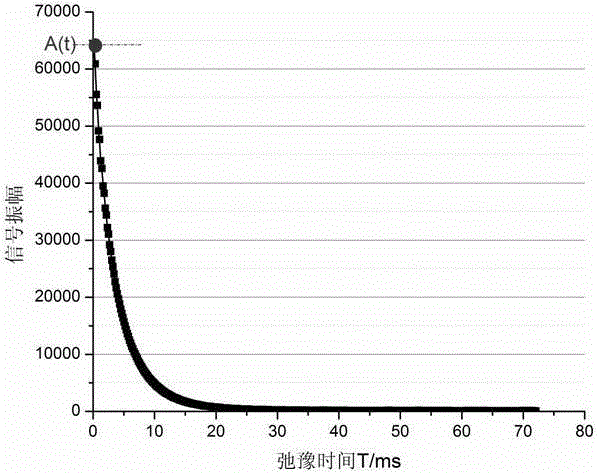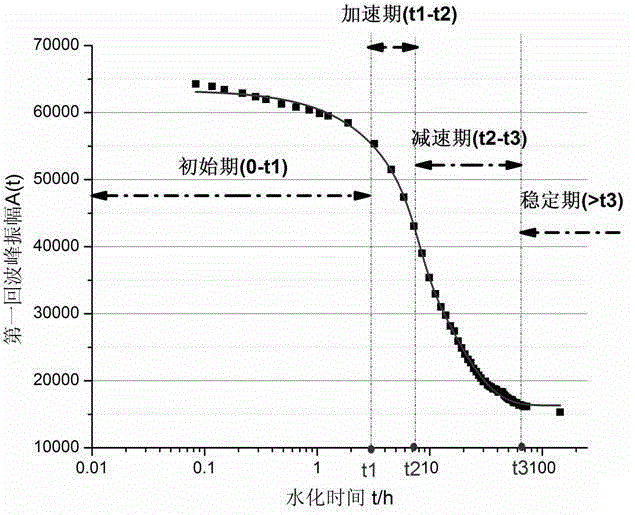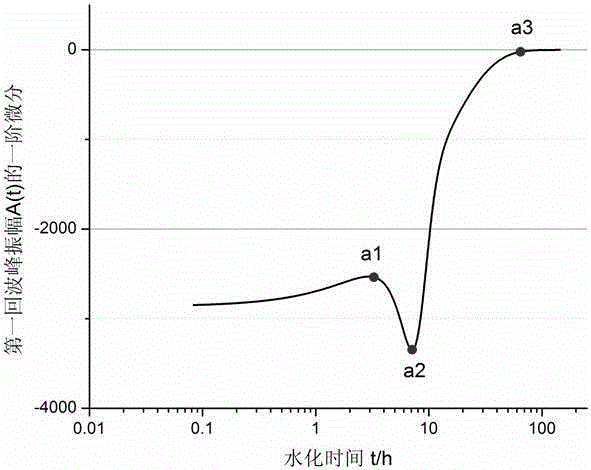Method for representing early-stage hydration process of cement with low-field nuclear magnetic resonance technique
A low-field nuclear magnetic resonance and cement technology, which is applied in the field of building materials, can solve problems such as signal distortion, complex test process, and improper handling of miscellaneous peaks, and achieve the effects of small data processing, convenient acquisition process, and less sample consumption
Inactive Publication Date: 2016-01-06
TONGJI UNIV
View PDF10 Cites 7 Cited by
- Summary
- Abstract
- Description
- Claims
- Application Information
AI Technical Summary
Problems solved by technology
These previous studies usually used the longitudinal relaxation time T of the hydrogen proton in the water molecule 1 or the transverse relaxation time T 2 To study the hydration process of cement, its disadvantages are: 1) The longitudinal relaxation time T 1 and the transverse relaxation time T 2 The test process is more complicated, and the inversion calculation of the original data is required, and the data processing is tedious and heavy; 2) use T 1 or T 2 The change of the weighted average is used to characterize the hydration process of cement, and the data calculation is complicated and difficult to understand and implement, especially if the T 1 or T 2 Improper handling of miscellaneous peaks in the distribution spectrum can easily introduce errors; 3) T 1 or T 2 The test is limited by the sample. Due to the presence of different contents of ferromagnetic substances in the cement, it is easy to cause the acceleration of the relaxation decay process, reduce the signal-to-noise ratio, etc., resulting in signal distortion.
4) The method of dividing the hydration stage is too rough. Generally, the turning point of the hydration process is judged subjectively by the experimenter based on the trend of the data points, which lacks accuracy
5) The collected T 1 or T 2 The change with the hydration time essentially reflects the change of the bound degree of water molecules, that is, the process of the pores in the cement paste gradually changing from large pores to small pores. This process is related to the hydration process, but It is not as direct as directly testing the changes in the content of physically bound water
Method used
the structure of the environmentally friendly knitted fabric provided by the present invention; figure 2 Flow chart of the yarn wrapping machine for environmentally friendly knitted fabrics and storage devices; image 3 Is the parameter map of the yarn covering machine
View moreImage
Smart Image Click on the blue labels to locate them in the text.
Smart ImageViewing Examples
Examples
Experimental program
Comparison scheme
Effect test
Embodiment 1
[0029] Example 1: Characterization of the early 145-hour hydration process of 42.5 ordinary Portland cement.
the structure of the environmentally friendly knitted fabric provided by the present invention; figure 2 Flow chart of the yarn wrapping machine for environmentally friendly knitted fabrics and storage devices; image 3 Is the parameter map of the yarn covering machine
Login to View More PUM
 Login to View More
Login to View More Abstract
The invention belongs to the field of construction materials, and particularly relates to a method for quickly and conveniently researching and representing the early-stage hydration process of cement with a low-field nuclear magnetic resonance technique. The method comprises steps as follows: a), an airtight sample tube containing cement paste is put into a low-field nuclear magnetic resonance instrument, and a test is started after different parameters and a sampling interval are set; b), nuclear magnetic relaxation attenuation signals at different hydration time points t are acquired through a CPMG (Carr-Purcell-Meiboom-Gil) pulse sequence; c), first echo peak amplitudes A (t) of attenuation curves at the hydration time points t are automatically acquired; d), obtained data points of A (t) and data points of t are subjected to fitting, and a relation curve obtained after A (t) and t are subjected to fitting is drawn; e), first-order and second-order differential curves of the fitted curve are drawn, and different hydration stages are divided according to a null point of the second-order differential curve; f), the hydration process of the cement is represented according to the three curves and time points of stages of the curves. The method is combined with a mathematical differential processing method for analysis of an experiment result, a turning point of a hydration reaction stage is accurately acquired, subjectivity of subjective judgment is overcome, the turning point is acquired more accurately and more visually, and a foundation is laid for research of the hydration process of the cement.
Description
technical field [0001] The invention belongs to the field of building materials, and in particular relates to a method for characterizing the early hydration process of cement based on low-field nuclear magnetic resonance technology. Background technique [0002] Cement is one of the largest building materials in the civil construction industry. Cement starts to undergo hydration reaction when water is added, gradually solidifies and hardens, and consolidates sand, stones, etc. together to form finished materials such as concrete. In the field of building materials, the characterization of the cement hydration process has always been one of the routine experimental projects for scientific research personnel in the industry and for enterprise R&D personnel to develop new products. Therefore, the research and development of new technologies and methods for characterizing the cement hydration process has broad application prospects. [0003] Water is an indispensable componen...
Claims
the structure of the environmentally friendly knitted fabric provided by the present invention; figure 2 Flow chart of the yarn wrapping machine for environmentally friendly knitted fabrics and storage devices; image 3 Is the parameter map of the yarn covering machine
Login to View More Application Information
Patent Timeline
 Login to View More
Login to View More IPC IPC(8): G01N24/08
Inventor 佘安明徐玉敬徐晶姚武杨培强高杨文
Owner TONGJI UNIV
Who we serve
- R&D Engineer
- R&D Manager
- IP Professional
Why Patsnap Eureka
- Industry Leading Data Capabilities
- Powerful AI technology
- Patent DNA Extraction
Social media
Patsnap Eureka Blog
Learn More Browse by: Latest US Patents, China's latest patents, Technical Efficacy Thesaurus, Application Domain, Technology Topic, Popular Technical Reports.
© 2024 PatSnap. All rights reserved.Legal|Privacy policy|Modern Slavery Act Transparency Statement|Sitemap|About US| Contact US: help@patsnap.com










